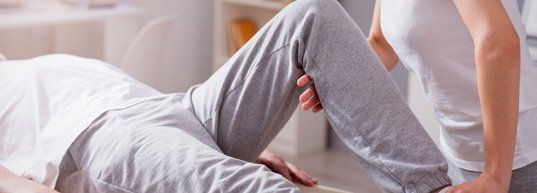Physical Therapy Services
Founded in 2001 | Most Insurance Accepted | Locally Owned
Founded in 2001 Most Insurance Accepted Locally Owned
Effective, Individualized Treatment Plans
Effective physical therapy can be life-changing. Let Carolina Sportscare & Physical Therapy help show you the way. Our experienced physical therapists can assist you in recovering from an injury or improving your athletic performance with a treatment plan that's individualized to your needs.
Please note that Adobe® Reader is free software that lets you view and print Adobe Portable Document Format (PDF) files. You may need to download the free program to view the files below.

Comprehensive Physical Therapy Solutions
- Athletic training coverage for local programs
- Custom orthotics
- Injury screenings
- Running evaluations
- Bike evaluations
- Swimming evaluations
- Guest speaker
- Orthopedic injuries
- Sports injuries, personal training, fitness, and wellness
- Non-surgical pain and rehabilitation solutions
- Aquatic rehabilitation
- Lymphedema management program
- Lymphedema prevention treatment (lower extremities)
- Lymphedema prevention treatment (upper extremities)
- Sports performance enhancement program
- Post-cancer recovery programs
- Body mechanics and ergonomic evaluations
- Sportsmetrics
- Trigger point dry needling
Treating Common Body Ailments and Pain Points
- Lower back
- Neck
- Shoulders
- Knees
- Ankles
Why Choose Carolina Sportscare & Physical Therapy?
What gives us the edge of over our competition?
- Years of experience
- More efficient treatments
- Convenient hours of operation
- Dedication of service
To schedule an appointment, please call us at 843-521-1970.
Orthopedic Injuries
Get back to your activity by overcoming pain and injuries.
Sooner or later, a sports-related injury may force you to seek help. Just look at these annual statistics:
- Golf – 660,000 injuries reported
- Baseball/softball – 245,000 injuries reported
- Bicycling – 421,000 injuries reported
- Tennis – 80,000 injuries reported
Now more than ever, you need our knowledge and experience to get you out of pain.
Get back with help from our team.
Imagine hitting the longest drive of your life. Imagine a smoother stroke of your tennis racquet or baseball bat, or being able to run faster and jump higher than before. Or get through a workday without pain.
We can help you do all that and more. We’ll guide your care with one person who routinely consults other staff to ensure your success. Our physical therapists and athletic trainers are highly skilled, well-educated and have over 55 years of combined experience. One member of our staff is even a Vodder-certified lymphatic drainage therapist who helps post-mastectomy patients.
Together they are experts who know how to get you back in shape and keep you in shape.
Get back with special help for active adults.
If you work fulltime, you treasure those special moments when you can play. But as your body ages, the chance of injury increases dramatically.
Your muscles lose size, tone and elasticity, and your reflexes slow. So while your brain is yelling, “Go, go, go,” your body is screaming, “Stop!”
When you get sidelined, turn to our expert team to get you back in the game. Why? Because we get better results fast.
Aquatic Rehabilitation
There are two properties of water that are used most frequently in the rehabilitation process, buoyancy and resistance.
Buoyancy is useful for relaxation and traction of the spine. The second is using the resistance of the water to exercise. No matter what direction you move the resistance of the water will be against you.
Both buoyancy and resistance are adjustable in the water. We can adjust the amount of buoyancy or floating you do with belts, floating dumbbells and noodles. We can adjust the resistance the water places on your movement with kick boards, gloves or paddles.
The wider and the more buoyant a device is the more resistance it will provide during movement in the water. Balance can also be assisted or challenged in the water. The natural properties of resistance can be exaggerated in the water with an external force.
The water can be used as an appropriate exercise medium for a variety of orthopedic and neurological disorders. Research shows that those who participate in rehabilitation programs with an aquatic component prior to surgery accelerate the rehabilitation process significantly. The water is also an ideal environment to begin an exercise program, and to rehabilitate injuries for those that suffer from osteoporosis, osteo-arthritis, rheumatoid arthritis and degenerative spine disorders.
The pool is a great way to get fit and to rehabilitate injuries. Using the mesh of science with exercise is always better than submerging into a program without them. With the appropriate amount of supervision and instruction you can maximize the benefits of the pool and decrease the risk of injury.
Carolina Sportscare and Physical Therapy utilizes the pool at the YMCA in Port Royal to provide care for those in need of pool-based rehabilitation. Kevin Green, PTA, MLDT, ARS is the only certified Aquatic Rehabilitation Specialist in the Low Country. If you are interested in more information regarding pool therapy please contact Carolina Sportscare and Physical Therapy at 843-521-1970 or ask your physician for a referral for pool therapy.
Lymphedema Management Program
Lymphedema Management Program is the low country’s most comprehensive lymphedema treatment program.
Carolina Sportscare offers new hope through the establishment of the Low Country’s most comprehensive Lymphedema Treatment Center. Staffed by a Vodder Institute Certified Manual Lymphatic Drainage Therapist, the center offers a program that effectively treats the special needs of those afflicted by this disorder. Carolina Sportscare’s Lymphedema Management includes programs for prevention, treatment and maintenance of lymphedema.
Referral to the Lymphedema Management Program is easy. A physician prescription is all that is needed to make an appointment. If you have questions please call Kevin Green Carolina Sportscare 843-521-1970.
Program Outline:
- Skin Care: Proper cleansing and rehydration of the skin maintains integrity and enhances elasticity.
- Manual Lymphatic Drainage: Patients receive Manual Lymphatic Drainage to remove excess fluid and protein.
- Bandaging: Aids in maintaining edema reduction achieved during treatment. Short stretch bandages, custom fit foam pieces and chip packs applied following treatment provide pressure to stimulate further drainage.
- Therapeutic Exercise: Stimulates the Lymph System by using muscle contractions as a pump for the lymph vessels. Exercises are performed in a therapeutic sequence to maximize drainage.
- Nutritional guidelines provided.
- Compression Garments: Benefits in decreasing edema; Decreases Fibrotic Hardening; Increases Independence; Improves physical appearance; Decreases infection rate.
Program Description:
Carolina Sportscare’s Lymphedema Management Program is the most comprehensive treatment center of its kind in the Low Country, treating individuals who suffer from Primary or Secondary Lymphedema.
Lymphedema, a form of high protein edema, is the chronic swelling of a body part caused by malformation or malfunction of the lymphatic system. It most often affects the arm or leg but can also occur in the face, neck, abdomen and other parts of the body.
The conditions may result in:
- Infection
- Multiple hospitalizations
- Open wounds
- Impaired ambulation
- Joint immobility
- Cosmetic deformity
- Vulnerability to injury
- Fibrotic hardening
- Difficulty with daily activities
- Pain / discomfort
- Amputation
- Lymph-angiosarcoma (rare)
- General depression
Program Services:
Using a combined decongestive therapy approach, Carolina Sportscare offers a team of highly trained professionals who provide total care to the lymphedema patient.
The program includes:
- Prevention: Through pre-surgical education and postsurgical home exercise packet. Treatment: Evaluation and measurements of
- Treatment: Evaluation and measurements of the affected side; pictures before and after treatment; Manual Lymphatic Drainage; Bandaging; and Exercise.
- Maintenance: Wellness Program which offers:
- Quarterly measurements
- Quarterly newsletter
- Quarterly support group
- Access to Carolina Sportscare’s
- Exercise facilities and personal training program
Lymphedema Prevention Treatment (Lower Extremities)
Eighteen steps to prevention lower extremities.
Brought to you by the National Lymphedema Network and Carolina Sportscare. For the patient who is at risk of developing lymphedema, and for the patient who has developed lymphedema.
Who is at risk?
At risk is anyone who has had gynecological, melanoma, prostate or kidney cancer in combination with inguinal node dissection and / or radiation therapy. Lymphedema can occur immediately postoperatively, within a few months, a couple of years, or 20 years or more after cancer therapy. With proper education and care, lymphedema can be avoided or, if it develops, kept under control.
The following instructions should be reviewed carefully preoperatively and discussed with your physician or therapist.
- Absolutely do not ignore any slight increase of swelling in the toes, foot, ankle, leg, abdomen, genitals (consult with your doctor immediately).
- Never allow an injection or a blood drawing in the affected leg(s). Wear a lymphedema alert necklace.
- Keep the edemic or at-risk leg spotlessly clean. Use lotion (Eucerin, Lymphoderm, Curel, whatever works best for you) after bathing. When drying it, be gentle, but thorough. Make sure it is dry in any creases and between the toes.
- Avoid vigorous, repetitive movements against resistance with the affected legs.
- Do not wear socks, stockings or undergarments with tight elastic bands.
- Avoid extreme temperature changes when bathing or sunbathing (no saunas or hottubs). Keep the leg(s) protected from the sun.
- Try to avoid any type of trauma, such as bruising, cuts, sunburn or other burns, sports injuries, insect bites, cat scratches. (Watch for subsequent signs of infection.)
- When manicuring your toenails, avoid cutting your cuticles (inform your pedicurist).
- Exercise is important, but consult with your therapist. Do not overtire a leg at risk; if it starts to ache, lie down and elevate it. Recommended exercises: walking, swimming, light aerobics, bike riding, and yoga.
- When travelling by air, patients with lymphedema and those at-risk should wear a well-fitted compression stocking. For those with lymphedema, additional bandages may be required to maintain compression on a long flight. Increase fluid intake while in the air.
- Use an electric razor to remove hair from legs. Maintain electric razor, properly replacing heads as needed.
- Patients who have lymphedema should wear a well-fitted compression stocking during all waking hours. At least every 4-6 months, see your therapist for follow-up. If the stocking is too loose, most likely the leg circumference has reduced or the stocking is worn.
- Warning: If you notice a rash, itching, redness, pain, increase of temperature or fever, see your physician immediately. An inflammation or infection in the affected leg could be the beginning or a worsening of lymphedema.
- Maintain your ideal weight through a well-balanced, low sodium, high-fiber diet. Avoid smoking and alcohol. Lymphedema is a high protein edema, but eating too little protein will not reduce the protein element in the lymph fluid; rather, this may weaken the connective tissue and worsen the condition. The diet should contain easily digested protein such as chicken, fish or tofu.
- Always wear closed shoes (high tops or well-fitted boots are highly recommended). No sandals, slippers or going barefoot. Dry feet carefully after swimming.
- See a podiatrist once a year as prophylaxis (to check for and treat fungi, ingrown toenails, calluses, pressure areas, athlete’s foot).
- Wear clean socks & hosiery at all times.
- Use talcum powder on feet, especially if you perspire a great deal; talcum will make it easier to pull on compression stockings. Be sure to wear rubber gloves, as well, when pulling on stockings. Powder behind the knee often helps, preventing rubbing and irritation.
Unfortunately, prevention is not a cure. But, as a cancer and/or lymphedema patient, you are in control of your ongoing cancer checkups and the continued maintenance of your lymphedema.
Lymphedema Prevention Treatment (Upper Extremities)
Eighteen steps to prevention upper extremities
Brought to you by the National Lymphedema Network and Carolina Sportscare. For the patient who is at risk of developing lymphedema, and for the patient who has developed lymphedema.
Who is at risk?
At risk is anyone who has had either a simple mastectomy, lumpectomy or modified radical mastectomy in combination with axillary node dissection and / or radiation therapy. Lymphedema can occur immediately postoperatively, within a few months, a couple of years, or 20 years or more after cancer therapy. With proper education and care, lymphedema can be avoided, or, if it develops, kept well under control.
- Absolutely do not ignore any slight increase of swelling in the arm, hand, fingers, or chest wall (consult with your doctor immediately).
- Never allow an injection or a blood drawing in the affected arm (s). Wear a LYMPHEDEMA ALERT bracelet.
- Have blood pressure checked on the unaffected arm, or on the leg (thigh), if bilateral lymphedema / at-risk arms.
- Keep the edemic or at-risk arm(s) spotlessly clean. Use lotion (Eucerin, Lymphoderm, Curel, whatever works best for you) after bathing. When drying it, be gentle, but thorough. Make sure it is dry in any creases and between the fingers.
- Avoid vigorous, repetitive movements against resistance with the affected arm (scrubbing, pushing, and pulling).
- Avoid heavy lifting with the affected arm. Never carry heavy handbags or bags with over-the-shoulder straps on your affected side.
- Do not wear tight jewelry or elastic bands around affected fingers or arm(s).
- Avoid extreme temperature changes when bathing or washing dishes, and it is recommended that saunas and hot tubs be avoided (at least keep arm out of the hot tub). Protect the arm from the sun at all times.
- Try to avoid any type of trauma (bruising, cuts, sunburn or other burns, sports injuries, insect bites, cat scratches) to the arm(s). (Watch for subsequent signs of infection.)
- Wear gloves while doing housework, gardening or any type of work that could result in even a minor injury.
- When manicuring your nails, avoid cutting your cuticles (inform your manicurist).
- Exercise is important, but consult with your therapist. Do not overtire an arm at risk: if it starts to ache, lie down and elevate it. Recommended exercises: walking, swimming, light aerobics, bike riding, and specially designed ballet or yoga. (Do not lift more than 15 lbs.)
- When travelling by air, patients with lymphedema (or who are at risk) must wear a well-fitted compression sleeve. Additional bandages may be required on a long flight. Increase fluid intake while in the air.
- Patients with large breasts should wear light breast prostheses (heavy prostheses may put too much pressure on the lymph nodes above the collar bone). Soft padded shoulder straps may have to be worn. Wear a well-fitted bra: not too tight, ideally with no underwire.
- Use an electric razor to remove hair from axilla. Maintain electric razor properly, replacing heads as needed.
- Patients with lymphedema should wear a well-fitted compression sleeve during all waking hours. At least every 4-6 months, see your therapist for follow-up. If the sleeve is too loose, most likely the arm circumference has reduced or the sleeve is worn.
- Warning: If you notice a rash, itching, redness, pain, increase of temperature or fever, see your physician immediately. An inflammation (or infection) in the affected arm could be the beginning or worsening of lymphedema.
- Maintain your ideal weight through well-balanced, low sodium, high-fiber diet. Avoid smoking and alcohol. Lymphedema is a high protein edema, but eating too little protein will not reduce the protein element in the lymph fluid; rather, this may weaken the connective tissue and worsen the condition. The diet should contain easily digested protein (chicken, fish, tofu).
Unfortunately, prevention is not a cure. But, as a cancer and/or lymphedema patient, you are in control of your ongoing cancer checkups and the continued maintenance of your lymphedema. To be screened for lymphedema, contact your doctor.
Body Mechanics
Positioned for Success
Truly ergonomic chair:
- Adjustable height to allow hips to be slightly above knees and feet to rest on the ground (or foot stool)
- Adjustable pan tilt to allow for proper weight placement on pelvic floor
- Adjustable backrest tilt to allow for proper low / mid back support
- Rolling on 5 casters
- Additional support as necessary using a lumbar pillow or towel behind to low back to maintain Lumbar spine position
General tips:
- Take breaks to avoid prolonged repetitive activities
- Active- take a break from current activity to perform alternate activity (i.e. computer work to returning phone calls)
- Stretch- perform postural flexibility exercises for neck, shoulders, and arms
- Walking- take a few minutes to walk to encourage circulation
Desk set up:
- Monitor positioned to allow straight ahead viewing
- Top of monitor to be at eye level
- Height of key board such that elbows can rest at side
- Object placement
- Items frequently used 0-12 inches
- Items occasionally used 12-24 inches
- Items seldomly used 24-36 inches

